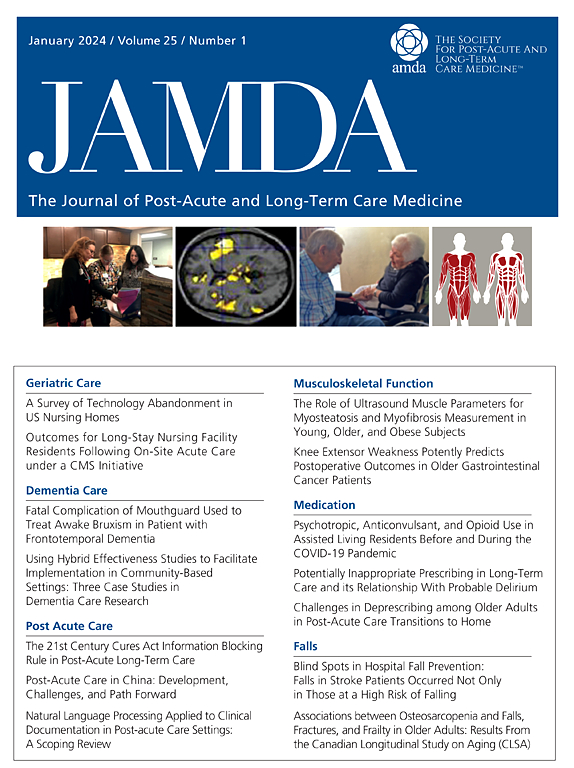痴呆诊断前后心脏代谢疾病相关住院的轨迹:一项匹配队列研究
IF 4.2
2区 医学
Q2 GERIATRICS & GERONTOLOGY
Journal of the American Medical Directors Association
Pub Date : 2025-05-09
DOI:10.1016/j.jamda.2025.105594
引用次数: 0
摘要
痴呆症与医疗保健使用增加有关;然而,住院时间与痴呆发展的关系尚不清楚。心脏代谢疾病(CMDs)包括2型糖尿病、心脏病和中风通常与痴呆共同发生,但痴呆对CMDs相关住院治疗的影响尚不清楚。我们的目的是绘制痴呆诊断前后与cmd相关的住院轨迹,并进一步确定与cmd相关的住院因素。设计匹配队列研究。背景和参与者在瑞典双胞胎登记中心,1657名年龄≥65岁的痴呆患者(58.8%为女性)与1657名无痴呆患者使用倾向评分进行匹配。方法对参与者进行长达20年的随访,以检测与cmd相关的住院情况。从医疗记录中确定痴呆症和与cmd相关的住院(计划内和计划外)。潜在的相关因素包括年龄、性别、教育程度、婚姻状况、吸烟、饮酒、体育活动、体重指数和高血压。数据分析采用泊松回归和广义估计方程模型。结果与对照组相比,痴呆患者与cmd相关住院的发生率从4年前开始增加[发病率比(IRR), 1.25;95% CI, 1.00-1.57],并在诊断后3年开始下降(IRR, 0.74;95% ci, 0.58-0.94)。痴呆症患者有更多的与cmd相关的住院治疗(IRR, 1.19;95% CI, 1.04-1.36)和更长的累计停留时间(IRR, 1.27;95% CI, 1.04-1.56),但诊断后这些比率下降。男性、吸烟、肥胖和高血压与痴呆症患者中与cmd相关的住院率进一步增加有关。结论和意义在痴呆发展过程中,与cmd相关的住院模式发生改变。我们的研究结果表明,即使在痴呆症诊断之前,医疗保健负担也会增加,而与cmd相关的住院治疗可能是未来痴呆症发病的早期征兆。本文章由计算机程序翻译,如有差异,请以英文原文为准。
Trajectory of Cardiometabolic Disease–Related Hospitalizations Before and After Dementia Diagnosis: A Matched Cohort Study
Objectives
Dementia is associated with increased health care use; however, the timing of hospitalizations in relation to the development of dementia remains unclear. Cardiometabolic diseases (CMDs) including type 2 diabetes, heart disease, and stroke often co-occur with dementia, but the impact of dementia on hospitalizations related to CMDs remains unknown. We aimed to map the trajectory of CMD-related hospitalization before and after dementia diagnosis and to further identify factors of CMD-related hospitalization.
Design
Matched cohort study.
Setting and Participants
Within the Swedish Twin Registry, 1657 participants aged ≥65 years (58.8% women) with incident dementia were matched with 1657 dementia-free participants using propensity scores.
Methods
Participants were followed for up to 20 years to detect CMD-related hospitalizations. Dementia and CMD-related hospitalizations (both planned and unplanned) were identified from medical records. Potential related factors included age, sex, education, marital status, smoking, drinking, physical activity, body mass index, and hypertension. Data were analyzed using Poisson regression and generalized estimating equation models.
Results
Compared with the control patients, the incidence of CMD-related hospitalization among people with dementia started to increase from 4 years before [incidence rate ratio (IRR), 1.25; 95% CI, 1.00-1.57], and started to decrease 3 years after, the diagnosis (IRR, 0.74; 95% CI, 0.58-0.94). People with dementia had a greater number of CMD-related hospitalizations (IRR, 1.19; 95% CI, 1.04-1.36) and longer cumulative length of stay (IRR, 1.27; 95% CI, 1.04-1.56) in the 5 years before dementia diagnosis, but these rates decreased after the diagnosis. Male sex, smoking, obesity, and hypertension were associated with further increases in CMD-related hospitalization among people with dementia.
Conclusions and Implications
Patterns of CMD-related hospitalization change over the course of dementia development. Our findings suggest that the health care burden increases even before the diagnosis of dementia, and CMD-related hospitalization may be an early sign of the future onset of dementia.
求助全文
通过发布文献求助,成功后即可免费获取论文全文。
去求助
来源期刊
CiteScore
11.10
自引率
6.60%
发文量
472
审稿时长
44 days
期刊介绍:
JAMDA, the official journal of AMDA - The Society for Post-Acute and Long-Term Care Medicine, is a leading peer-reviewed publication that offers practical information and research geared towards healthcare professionals in the post-acute and long-term care fields. It is also a valuable resource for policy-makers, organizational leaders, educators, and advocates.
The journal provides essential information for various healthcare professionals such as medical directors, attending physicians, nurses, consultant pharmacists, geriatric psychiatrists, nurse practitioners, physician assistants, physical and occupational therapists, social workers, and others involved in providing, overseeing, and promoting quality

 求助内容:
求助内容: 应助结果提醒方式:
应助结果提醒方式:


